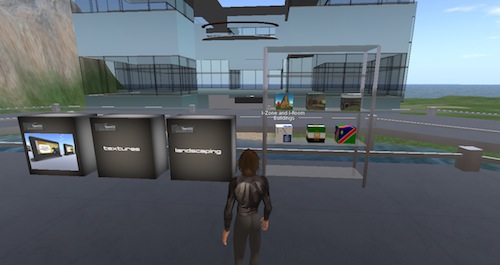I’m defintely in the huge cohort of people who loves Angry Birds. At least now one mystery is solved: who created them?

Tech -- Culture -- Humour
I’m defintely in the huge cohort of people who loves Angry Birds. At least now one mystery is solved: who created them?

Like a lot of virtual worlds observers, I’ve written repeatedly on the need for virtual worlds like OpenSim and Second Life to be simpler to use – ideally web browser based. Kitely, a project underway since 2008, takes a big step toward achieving that by making the establishment of an OpenSim grid nearly as simple as it gets.
It took me under ten minutes to get set up in Kitely. Here’s how:
1. Log in via Facebook Connect.
2. Install the Kitely plugin (Mac users note: Safari or Opera aren’t currently supported by the Kitely plugin at present, you’ll need to use Firefox or Chrome).
3. Create a world and choose if you want to invite anyone from Facebook groups you are part of:

4. Type a name, optional description and type of world you want to start with.
5. Click on ‘Enter World’ and your SL browser will launch (Mac users again – there’s a known bug whereby your username and password are all entered in the Name field of the SL browser – you just need to type in that password and delete it from the end of your name)
5. Voila – you’re now on your own island / collaborative space:

6. Three minutes later and I had my venerable log cabin rezzed on my island:

Kitely is currently in beta, and the currency used is called a KC. As part of the beta you get 50 KCs currency to start with and it costs 1KC per day to keep each world you create. On the proposed maximum discount structure that works out at US ten cents per month. It’s an attractive proposition for someone not wanting the hassle of creating their own grid from scratch and its more than competitive with other providers. The support functionality is fairly well set up and responsive from what I’m seeing.
There’s still plenty of kinks to iron out but Kitely is a superb snapshot of what is going to be required for wider adoption of virtual environments: simplicity and integration with other platforms. I’d be interested to hear from anyone who has experience in creating content in OpenSim as to your thoughts on comparability to other offerings. It’s also worth having a read through the Kitely FAQ, which covers a lot of stuff including the approach to intellectual property (essentially the same as Second Life) and the Terms of Service.
Thanks to a number of Metaverse Journal twitter followers for the heads-up.
Update: With thanks to reader Psx_kai, who pointed out a key fact I’d missed in the story. The pricing I described was correct but didn’t include the extra charge of US$0.20 per minute for each visitor to your world. That’s certainly going to get pricey after a while although it seems it’s going to be an option to earn a fair whack of free KCs. On the upside, the ‘pay for what you use’ model is something that can work well for those wanting intermittent events without the ongoing higher monthky costs on say Second Life.
Released in 2009, a short film called ‘the third & the seventh’ was released. Created by Alex Roman. it’s essential viewing for anyone in doubt about the future of computer-generated images in film. Computer-generated or not, it’s one of the most stunning pieces of work I’ve seen. Have a look for yourself (watch in full screen / maximised mode):
The Third & The Seventh from Alex Roman on Vimeo.
The most exciting thing about this for the coming 5-10 years, is the ability for creative people with more limited budgets to be able to realise their visions in full. Does it get any better than that?
 One of the most frequent questions I’m asked (after “Is Second Life still around?”), is what large businesses are still actively involved in Second Life. I noticed this afternoon while reading my RSS feeds that Daniel Voyager has compiled a list of those at the big end of town still involved.
One of the most frequent questions I’m asked (after “Is Second Life still around?”), is what large businesses are still actively involved in Second Life. I noticed this afternoon while reading my RSS feeds that Daniel Voyager has compiled a list of those at the big end of town still involved.
They include Air France, Cisco Systems, Dell, IBM and Siemens (pictured). All businesses featured on Daniel’s list have SLURLs so you can have a look for yourself.
 Here at Cultured Tech we get some interesting press releases. One of the more interesting ones was released this week. Interesting as in being a little different from the bog standard “hey we’ve released a new gadget”. Although still a gadget, vibrators don’t tend to make the tech beat often, and it only really does this time because it looks a lot like a mouse. Called the The Be Be, it’s the creation of two women from Wollongong (Australia).
Here at Cultured Tech we get some interesting press releases. One of the more interesting ones was released this week. Interesting as in being a little different from the bog standard “hey we’ve released a new gadget”. Although still a gadget, vibrators don’t tend to make the tech beat often, and it only really does this time because it looks a lot like a mouse. Called the The Be Be, it’s the creation of two women from Wollongong (Australia).
For your entertainment I’ve provided the full press release, all puns included:
It’s not everyday you read about two savvy mothers from Wollongong launching a ground breaking product aimed at the sensuality and well being of women, but then you probably haven’t met Kristine Morgan and Lisa Hughes.
These two friends were enjoying a morning run along their local beach in Wollongong when they started talking about women and their conversation turned to vibrators (as friends’ conversations sometimes do). ‘Do you think any of the vibrators out there are actually designed by women?’ Kris asked. ‘Seriously, why can’t we buy a vibrator that looks great and better still, feels great!’
The friends laughed. Kris had a point. ‘We’re women. We love beautiful things’, added Lisa. ‘So what’s with all the tacky imagery and packaging? Why can’t normal women, walk into a normal shop and buy a vibrator like it’s a totally normal thing to do?’ By the time they had finished their run, the girls were sweaty, buzzing with excitement and eager to get some answers. And so their research began.
‘We really wanted to understand what other women thought of this whole market,’ explains Lisa. ‘And who better to understand what women really want, than women who really want it?’
After talking to ‘real’ women everywhere – mothers, daughters, sisters, wives, and girlfriends – Kris and Lisa’s company, Love Being Woman was born.
‘The brand is really about inspiring and empowering women from all walks of life,’ says Lisa. ‘We live by the philosophy that ‘when you feel good about yourself, you can give the best of yourself to others’.
After holding a series of intimate and fun focus groups Kris and Lisa knew they were onto something special. They had spoken to hundreds of women who wanted an intimate massager that was enjoyable to use and that they weren’t embarrassed to buy. They wanted something that suited their lives, their style, their needs. An intimate massager that was discreet, high quality,feminine, accessible and best of all worked!
From that moment on the girls spent every waking minute (when they weren’t being wives and mothers) finding out everything they could about vibrators. They even had their husbands on alert for any information that would help them with their mission.
After months laughing and looking, designing and experimenting, their work finally paid off and THE BE BE was born, Be beautiful, Be you! ‘This is all about making women feel confident in and out of the bedroom,’ explains Lisa. ‘This is not just about launching a new vibrator. It’s about saying it’s great for women to explore their sensuality. This is about their health and wellbeing and giving them the right to be in charge.’
‘We developed THE BE BE so women can feel empowered, not embarrassed,’ states Kris.
‘THE BE BE is about feeling sexy, not sex obsessed.
“Happy not inhibited, Frisky not frustrated.â€
THE BE BE is the first product from Love Being Woman and has been designed to embody the Love Being Woman philosophy. Kristine and Lisa live by the philosophy
‘When you feel great about yourself, you give the best of yourself to others’.
They hope you’ll discover this philosophy too.
For more information and pricing (currently around the AU$120 mark), check the Be Be’s website.
Two sisters, one blonde and one brunette, inherit the family ranch.
Unfortunately, after just a few years, they are in financial trouble. In order to keep the bank from repossessing the ranch, they need to
purchase a bull so that they can breed their own stock.
Upon leaving, the brunette tells her sister, ‘When I get there, if I decide to buy the bull, I’ll contact you to drive out after me and haul it home.’
The brunette arrives at the man’s ranch, inspects the bull, and decides she wants to buy it. The man tells her that he will sell it for $599, no less.
After paying him, she drives to the nearest town to send her sister a telegram to tell her the news. She walks into the telegraph office, and says, ‘I want to send a telegram to my
sister telling her that I’ve bought a bull for our ranch. I need her to hitch the trailer to our pickup truck and drive out here so we can haul it home.’
The telegraph operator explains that he’ll be glad to help her, then adds, it will cost 99 cents a word.’ Well, after paying for the bull,
the brunette realizes that she’ll only be able to send her sister one word.
After a few minutes of thinking, she nods and says, ‘I want you to send her the word ‘comfortable.’
The operator shakes his head. ‘How is she ever going to know that you want her to hitch the trailer to your pickup truck and drive out here to
haul that bull back to your ranch if you send her just the word ‘comfortable?’
The brunette explains, ‘My sister’s blonde. The word is big. She’ll read it very slowly…. ‘com-for-da-bul.’
 The folks over at XKCD have created a brilliant comparative chart showing examples of key activities generating radiation and the levels to which humans can cope with them. The format provides an excellent sanity check for a lot of the hysteria around at the moment, whilst also showing some casuses of radiation that you’ll be less aware off.
The folks over at XKCD have created a brilliant comparative chart showing examples of key activities generating radiation and the levels to which humans can cope with them. The format provides an excellent sanity check for a lot of the hysteria around at the moment, whilst also showing some casuses of radiation that you’ll be less aware off.
Draxtor Despres has created a machinima on a great Second Life installation that takes the Gettr functionality on Flickr and merges it into an underwater Second Life installation. Have a look for yourself:
 1. TUAW (USA) – Enterprise virtual worlds vendor ProtonMedia promises Mac client. “ProtonMedia says that increasing use of Macs in businesses means it’s now developing a Mac version of its respected virtual worlds software ProtoSphere, a virtual collaboration environment. Although the Windows version of its software is built on Microsoft technology, the company says its architecture means it can fairly easily port it over to the Mac.”
1. TUAW (USA) – Enterprise virtual worlds vendor ProtonMedia promises Mac client. “ProtonMedia says that increasing use of Macs in businesses means it’s now developing a Mac version of its respected virtual worlds software ProtoSphere, a virtual collaboration environment. Although the Windows version of its software is built on Microsoft technology, the company says its architecture means it can fairly easily port it over to the Mac.”
2. The Guardian (UK) – British hacker jailed over £7m virtual gaming chips scam. “A British computer hacker who stole 400bn virtual gaming chips from an international gaming company has been jailed for two years. Ashley Mitchell, 29, broke into the Zynga mainframe, stole the identity of two employees and transferred chips said to be worth more than £7m to himself. Mitchell, of Paignton, Devon, sold the chips through Facebook to other gaming enthusiasts and used the money to fund his online gambling addiction. More than 50 million people a day play Zynga games, including Mafia Wars, in which players run a virtual mob business, and FarmVille, which allows users to create their dream farm. Players have to buy chips for their virtual worlds. A black market in cut-price chips has grown up on the internet.”
3. Massively (USA) – Celebrate EQ’s 12 years with a look back and an interview with John Smedley. “Time grows many layers, and this is especially true in MMORPGs. After all, not only are new quests, stories and chunks of content added to a game as it goes along, but the players themselves add their own memories and experiences to the mix. MMOs truly are virtual worlds, and they change over time and become richer. EverQuest is no exception. After 12 years of adventure, danger, and story-telling, the game shows no signs of stopping. What is planned for the game? How will the last 12 years affect the decisions for the next 12 years? EverQuest has been one of the flagships of the genre, but how does a game of its age maintain any type of market visibility?”
4. Victoria Times Colonist (Canada) – ‘Uther’ worldly class offers a real world benefit -dinner. “Imagine that you could take cooking lessons from a top chef in your own kitchen. And imagine that chef is halfway around the world from where you are. At UtherAcademy’s Kitchen Corner cooking school, it matters not if the chef is in Egypt and his cooking school students are in Nanaimo, Whalley or Tuktoyaktuk. Once inside the three-dimensional virtual classroom the chef and his students -as animated avatars -are in their world, talking freely, asking questions and demonstrating techniques in French cooking, knife skills, pickling and food hygiene. When class begins next week, six students will enter Kitchen Corner with chef Peers Cawley to begin 12 weeks of hands-on cooking instruction.”
5. BBC (UK) – Children ‘give playground games a modern twist’. “Children are using their experience of computer games and reality TV shows to give traditional playground games a modern twist, a study suggests. Researchers found aspects of programmes like the Jeremy Kyle Show and Britain’s Got Talent included in children’s imaginative play. Far from destroying their imagination, new technologies help to enrich it, the team from London and Sheffield says. They observed play at two school playgrounds over two years. The researchers from London’s Institute of Education, University of East London and the University of Sheffield, also drew on archived recordings of children playing made by play researchers in the 1960s, 1970s and 1980s.”
6. Gamasutra (USA) – Should MMOs be more like single-player games? “Most of today’s single-player action games like Bioshock and Assassin’s Creed have around 15-25 hours of gameplay. These games share some similarities as the player progresses: the character gains more abilities that affect gameplay (weapons, moves, new mission types, etc), he advanced in a linear story, meets new characters, kills new enemies and often has the chance to explore something extra. Also they all share about the same payment method: you pay around $40 and you have access to all the game for as long as you like. They are also, of course, single-player experiences. In most MMOs today, like in World of Warcraft, you take 20 hours to reach a third or less of the your game progression. And, most of the time, that means little gameplay, hardly any story, a multitude of disposable npcs and tons of variants of the same enemies, all of that often focused on a limited repetition of completing the same kinds of quests with the obvious lack of effect to the game world.”
7. Fast Company (USA) – The 10 Most Innovative Companies in Gaming. “01 / Zynga >>For dominating–and monetizing–the social-gaming industry. The largest social-games developer in the world touts hundreds of millions of monthly active users on FarmVille, Treasure Isle, Zynga Poker, Mafia Wars, and more. But what’s truly innovative is its all virtual-goods revenue model: By creating immersive, addicting games, Zynga has roped gamers into paying real money for make-believe “virtual” goods that let them move up in the games or to give their friends gifts. Although small, those numbers add up: Zynga is already profitable, and it’s valued at more than $7 billion.”
8. The Nation (Pakistan) – The Powers of Thought. “It is not enough to have a good mind; the main thing is to use it well, said the 17th century French philosopher Rene Descartes. True enough. Three days ago, an announcement by German scientists revealed how science is moving towards doing just that. Driving a car using the power of thought is the latest advance in linking the brain to a computer. Scientists at the Free University of Berlin have connected commercially available sensors that record brain activity—technically, EEG, or electroencephalogram sensors—to a computer-controlled sedan, which means the car is now controlled by thoughts. It was obviously not a good idea to do the test on a road, so Berlin’s mothballed Tempelhof Airport was chosen to prove the concept.”
9. Big Think (USA) – Walking Across Campus Whilst Sitting on your Couch. “This might at first sight sound like an oxymoron but it could be part of a future campus environment. Last year a couple of tech start-ups presented their first so called “telepresence robots†ready to be commercialized. The one that got the most attention from the tech scene is AnyBots. Michael Arrington, founder of the popular tech blog TechCrunch even changed his Twitter profile picture to an AnyBots QB after he had had the chance to play around with it in the TechCrunch offices last year.”
10. Computerworld (USA) – Display tech to watch this year: Haptics create a buzz. “If multitouch display technology is proliferating, haptic feedback is helping to fuel the trend. Haptics provide tactile feedback to your fingers as you touch a display by vibrating all or part of the display surface. Haptic technology is on a roll; it’s been adopted in more than 20 smartphone models, including the Nokia N8 and Samsung Galaxy S series, because it can help people interact with touch-screen applications more accurately and otherwise enhance the user experience, says Jennifer Colegrove, an analyst with DisplaySearch. DisplaySearch, a Santa Clara, Calif.-based research firm that focuses on the display market, hasn’t yet released growth projections for haptics, but Colegrove notes that tablet PCs are ripe for the technology. One tablet that already includes haptics is Samsung’s Galaxy Tab, which has sold 2 million units since its launch in September of last year.”
I doubt there’s anyone who’ll claim that teleconferences or videoconferences are the most engaging way to communicate. Sure, you can pull faces on a teleconference or play games on your smartphone out of camera shot, but at the end of the day both methods are poor substitutes for a face-to-face meeting.
Attempting to bridge that gap are companies like Anybots, who are creating telepresence robots that allow a videoconference participant to have a little more control and interaction with a remote team. Check it out:
I’m not convinced on this being adopted widely – I think some other telepresence options and virtual world options offer something even more engaging. That said, the bot is cute and mobile, so it’s definitely an improvement on the status quo.
[via Big Think]
Copyright © 2025 · Magazine Child Theme on Genesis Framework · WordPress · Log in
Recent Comments